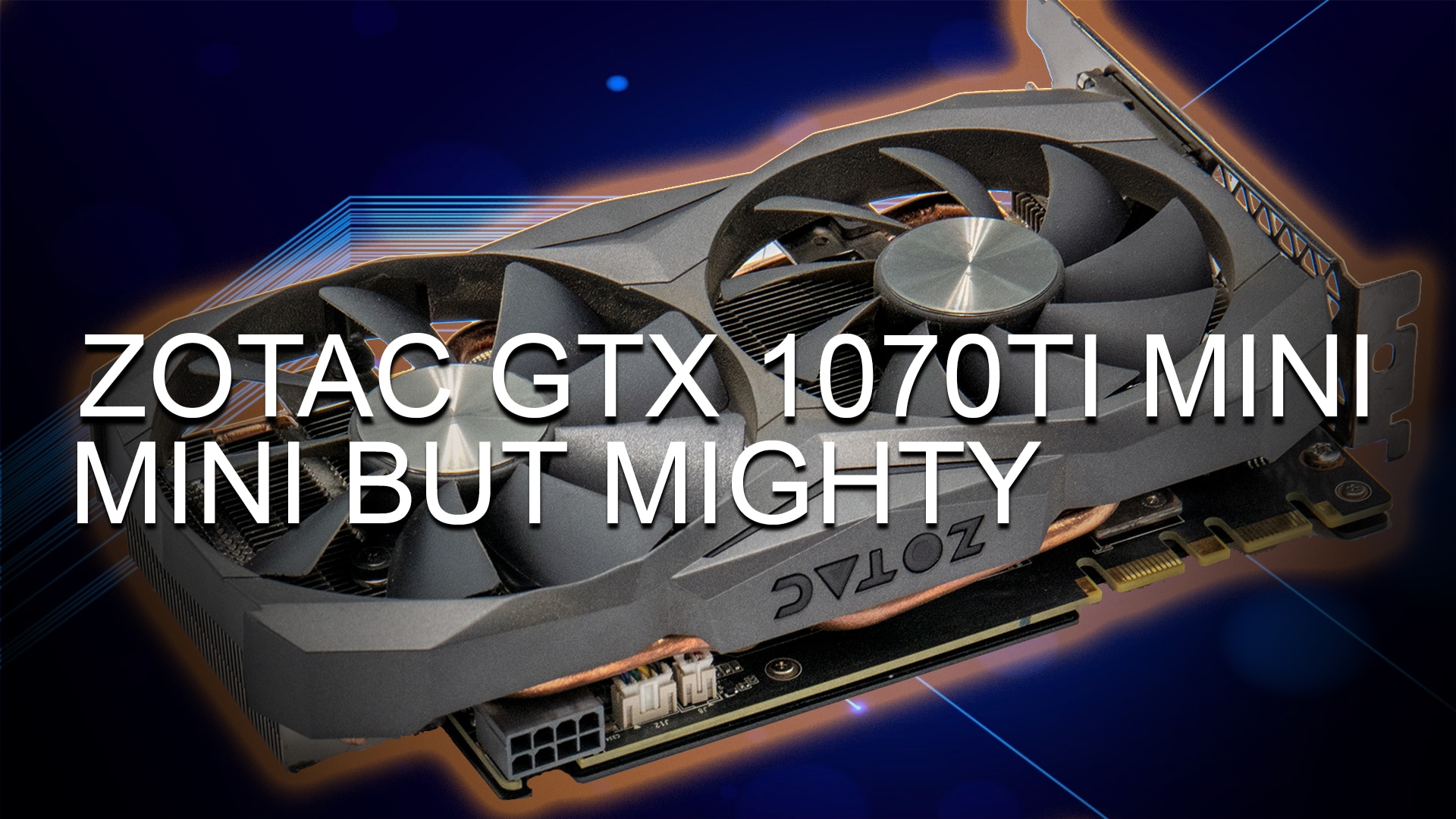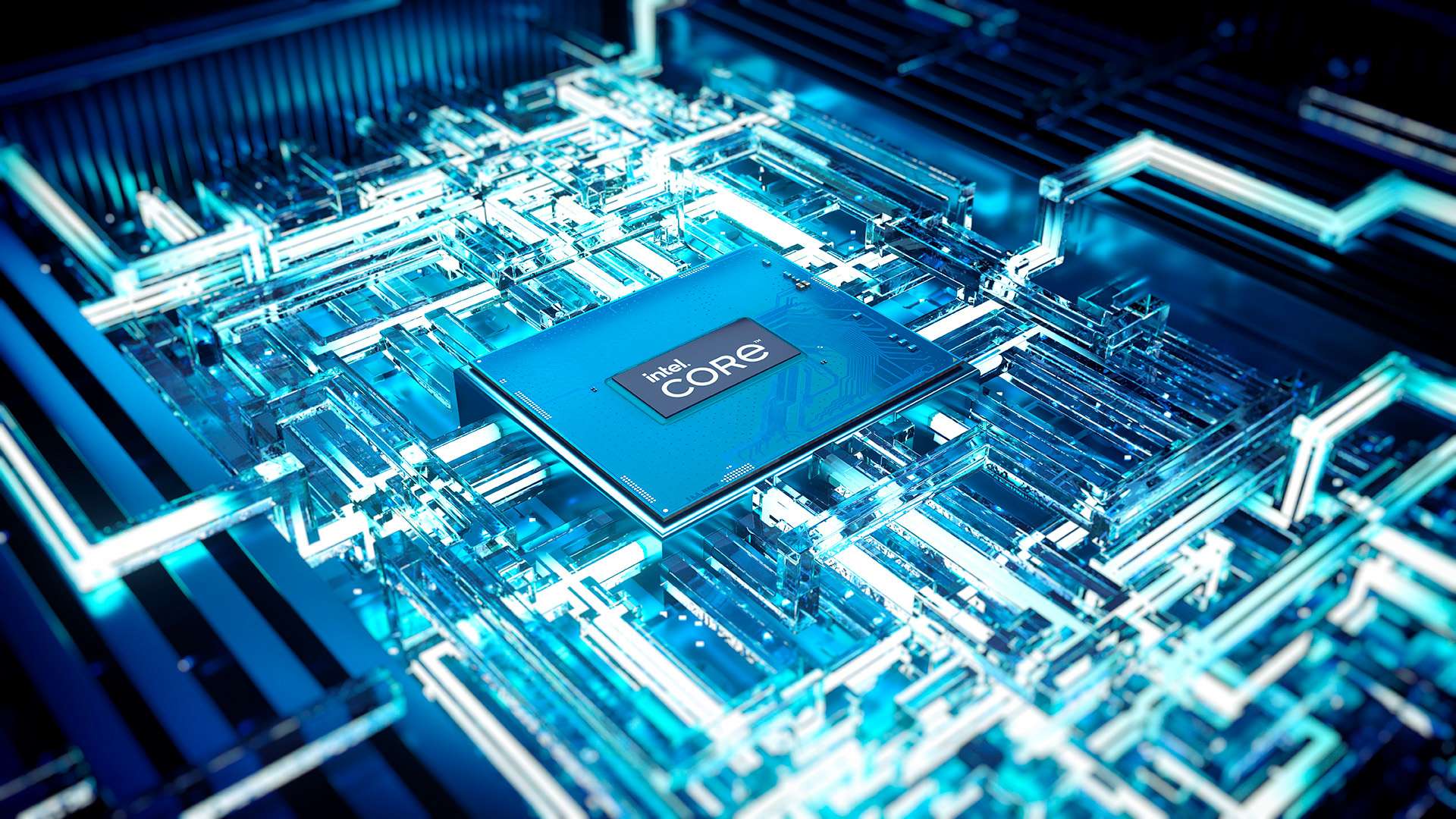
The shipping container for the Zotac GeForce GTX 1070Ti Mini is classic Zotac. That is to say it marches to the beat of its own drum. To say ‘yellow’ is a unusual color for a hard core gaming line of cards is an understatement. Somehow though ‘Zotac Yellow’ just plain works. Maybe it because others are content to follow the pack and use mainly red or black the yellow shipping containers simply stand out in a sea of sameness. Regardless of how it does it the combination of yellow with black accents actually works. Mix in good list of information of the card housed inside and this shipping container is rather impressive.
One thing that may confuse some is the shear size of this box… as while the label may say ‘mini’ this box is anything but. This is because while it may house a mini(ish) sized video card Zotac has recycled their full sized models’ shipping container for it. The upside to this is the amount of foam surrounding this card is rather remarkable.
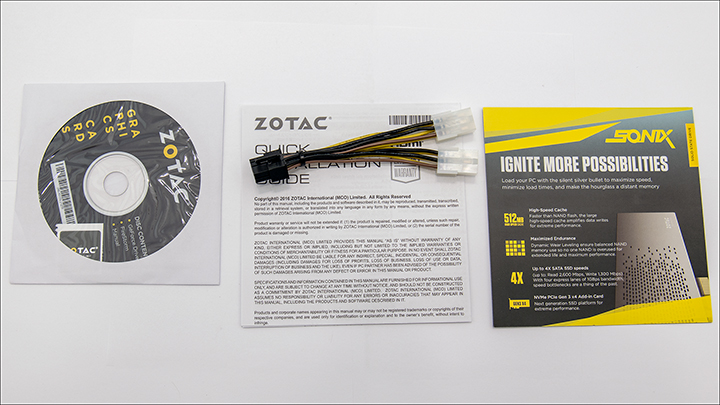
The accessories though are a touch on the… mini side. Basically, you can expect to find a software and drivers disc, information pamphlet, and a nice dual 6pin to one 8-pin adapter. Though it is not exactly fair to call this selection of accessories mini, rather it is pretty standard. It is just they stand in stark contrast to the up-sized shipping container.
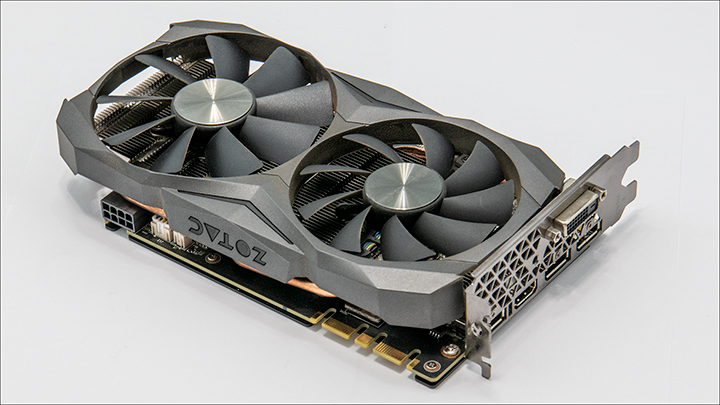
Before we begin, a bit of backstory is required to understanding exactly what ‘mini’ refers to. Much like every other standard the PCI and PCIe standards describe precisely what dimensions are ‘allowed’. While usually used in reference to Solid State Add In Cards they actually do have meaning when it comes to video cards – its just that video card manufactures usually just ignore most of them. For both the height and the length there are two distinct sizes (the width is frozen at 0.6 inches and why most cards are ‘2 slot’ or ‘2.5’ slot form-factored devices). These are ‘half’ and ‘full’. Half-height (aka ‘HH’ what most SSD AICs use) are 79.2mm / 3.118 inches tall, while full-height (‘FH’) are 120mm / 4.7 inches tall. Half-length (aka ‘HL’… which is what most SSD Add In Card models use) are 175.26mm / 6.9 inches long, while full-length (‘FL’) are 312mm / 12.283 inches in length

Most ‘mini’ or ‘ITX’ (or etc. etc. that a given manufacturer uses for this smallest form-factor cards label) video cards are either Full-height or half-height and half-length – with FHHL being the most common. The Zotac GeForce GTX 1070Ti Mini does not quite qualify as a true ‘mini’ FHHL card as it is 8.31 inches long and 4.92 inches tall. While this does mean the Zotac GeForce GTX 1070Ti Mini may not fit in some ‘shoe box’ builds it still is a lot easier to work with than the typical ‘full sized’ card – as it is still noticeably shorter than the typical video card that are 10.5 inches or better in length. In their literature Zotac promise ‘99%’ compatibility with cases and while they may be a tad high it is in the general ballpark.
Basically, most people will not notice the slightly added length over the usual ‘mini’ or ‘compact’ cards as it still will be extremely easy to work with even in smaller m-atx cases. It really is only with some mITX cases that the Zotac GeForce GTX 1070Ti Mini will be contraindicated… in that you will be in for a very bad day that will require a good dose of ‘sawzall therapy’.
Now saying this card is small really does not do it justice. Here it is compared to a fairly typical GTX 1070Ti – the MSI Gaming X 1070Ti:

Here it is compared to a more classical ‘mini’ card – the MSI Aero ITX 1070.

As you can see it really is not that much bigger than the typical ‘mini’ video card options that other manufactures offer… and yet it is down right tiny compared to the ‘typical’ dual fan 10-series cards.

The reason for these extra dimensions is pretty simple to suss out once you flip the Zotac GeForce GTX 1070Ti Mini over. As you can see the it may indeed use a standard half-length sized PCB but Zotac has attached an extremely large -for its class – custom cooling solution that over hangs the end of the PCB. This is also how Zotac were able to fit two large (90mm rear, 100mm front) fans on a mini card. As an added bonus this also how Zotac were able to fit four heat pipes in that (relatively) large aluminum fin array… which eons better than the two or three heat pipes you can expect from typical mini cards.

More importantly, this heatsink may indeed be compact but it is a variation of Zotac’s legendary ‘IceStorm’ design. Needless to say it is indeed rather potent. At stock frequencies this small video card not only allows the GP104 to run in the 1850’ish range 24/7 but also allows the fans to only ramp up to about 50-55 percent. The one downside is that there is no ‘zero decibel’ option for these fans. The stock fan profile lowers them to about 35 percent (an inaudible whisper) but they are ‘always on’ unlike some other 1070Ti models that allow the fans to stop when in 2D only mode. This is because the heatsink is smaller than ‘regular’ sized options used on the typical video card… and IceStorm or not the lack of surface area means some active air flow is needed to keep temperatures in check. However, even with this one minor caveat we are still impressed with this mini version of the IceStorm design.
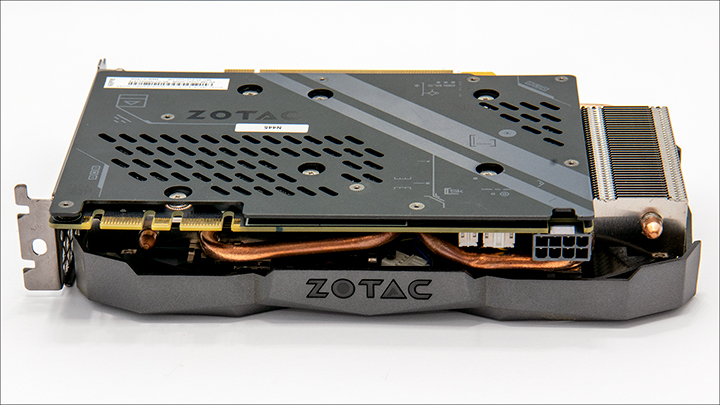
Before taking a closer look at the top one other thing will pop out for those who look carefully – this reasonably priced mini card actually comes with a proper backplate. This nicely finishes off the overall aesthetics of the Zotac GeForce GTX 1070Ti Mini but as there are no heat pads connecting this thick chunk of metal to the PCB it is not being utilized as a heat spreader. Which is a shame. Instead it is just there for looks and protecting the PCB from accidents (e.g. dropped screwdrivers, etc. etc.).
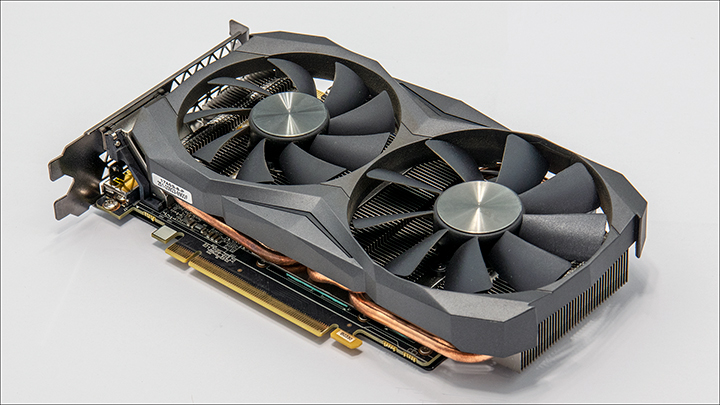
The top covering / fascia is also impressive. Instead of the typical colored plastic that most companies use on their FHHL cards Zotac has instead opted for gunmetal gray colored metal. For those interested in lighting options there are two large chevrons located at each edge of this covering at about the midway mark between the two fans. These chevrons are plastic diffusers for the numerous LEDs Zotac has seen fit to include. These in addition to the Zotac logo glow a nice subtle white when the video card is powered up, but white is the only color option. So while it does goes nicely with the gray of the fascia we would have liked to have seen more LED color options (including an off option) but overall this is one elegant looking design for its class.
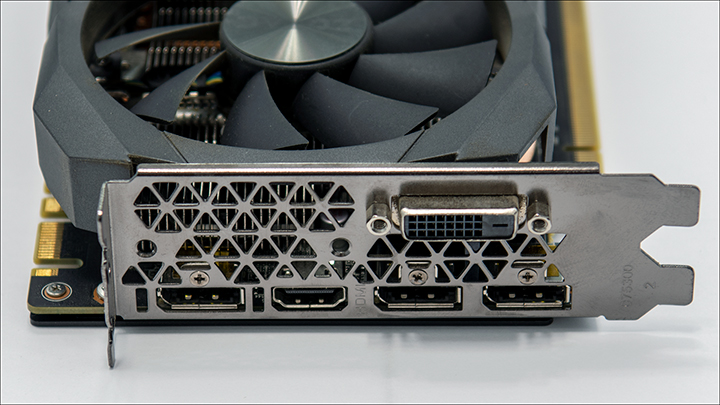
Further reinforcing our positive first impression is the Zotac GeForce GTX 1070Ti Mini has a very nice list of output ports. In grand total you will find three full sized DisplayPort (1.4) ports, a single full sized DVI port, and one HDMI (2.0b) port. This is list should be more than good enough for the average system… and not require anyone to break out the mini-adapters like you have to do on some other mini cards.
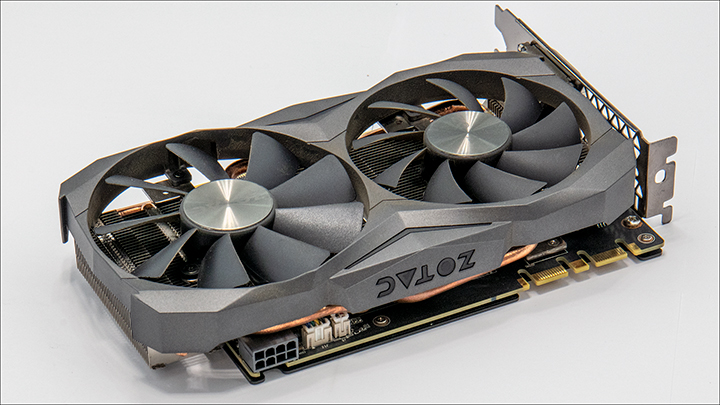
The only minor disappointment is in the power delivery department. With a maximum power draw of 75 watts from the PCIe slot and 150 from the lone 8-pin PCIe power port this card will max out at 225watts. Since this card is limited by NVIDIA decree to a maximum of 120 percent power this is enough (180 * 1.2 is only 216 watts) but we would have liked to seen Zotac go even further like they do their AMP series and offer even higher OC capabilities for all their cards (e.g. the AMP! Extreme can do 140% via download OC profile). By the same token this the same max power draw that much larger cards like the EVGA GeForce GTX 1070Ti SuperClocked Black Edition have… so while a tad disappointing it is still decent. It is just that with such attention to detail paid to every other portion of this we do wish a bit more had been paid to overclocking potential.

Speaking of the software the Zotac FireStorm v2 software is actually pretty nifty… albeit with two caveats. Let’s start with the good. In addition to being able to create custom overclocking profiles and fan curves you can also modify the lights (of any model that comes with ‘Spectra’ RGB LEDS). Of course, that is all pretty decent but would not make anyone using MSI Afterburner (or etc. etc.) want to change. What may is those ‘oc profiles’ that Zotac makes available with the specific Zotac Firestorm versions (i.e. they have multiple software versions with different OC profiles baked in for specific cards… including a 140% TDP variant for their flagship AMP! Extreme 1080Ti). We quite honestly are surprised that NVIDIA allows them to do this as they do completely ignore NV’s mandates on maximum TDP for overclocking. By the same token as they are not implemented by default, and you have to manually implement them, and Zotac will be the one on the hook for nuking the video card processors we are sure that it skates right to the very edge of what NVIDIA will tolerate. We just wish more companies were as willing to go the extra mile in helping enthusiasts.
Now for the caveats. It only will see four cards. So miners need not apply. That is a touch disappointing but has zero bearing on this mini card which is more orientated towards the mainstream public rather than miners. The other is that the OC option will be MIA if it does not see a Zotac card. Instead you will only be able to manually overclock the card. As such we strongly recommend trying it out if you do have a Zotac card instead of using your ‘old reliable’ app of choice.
